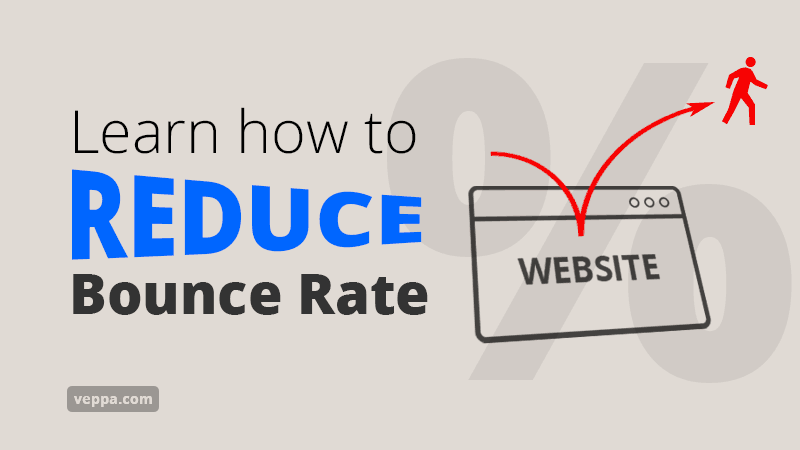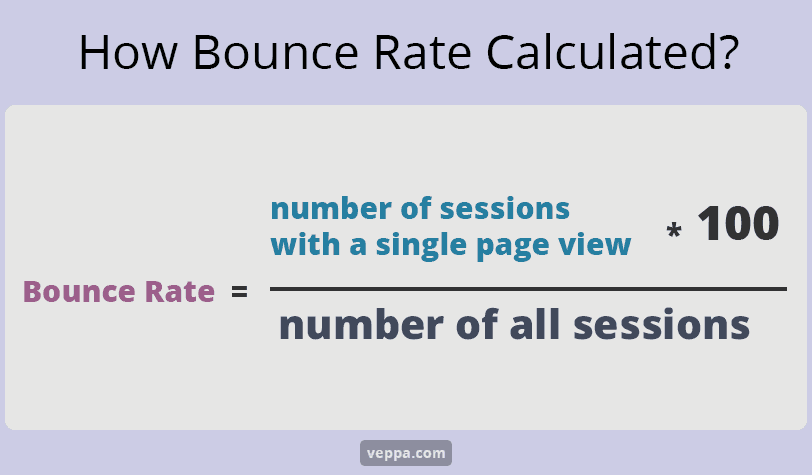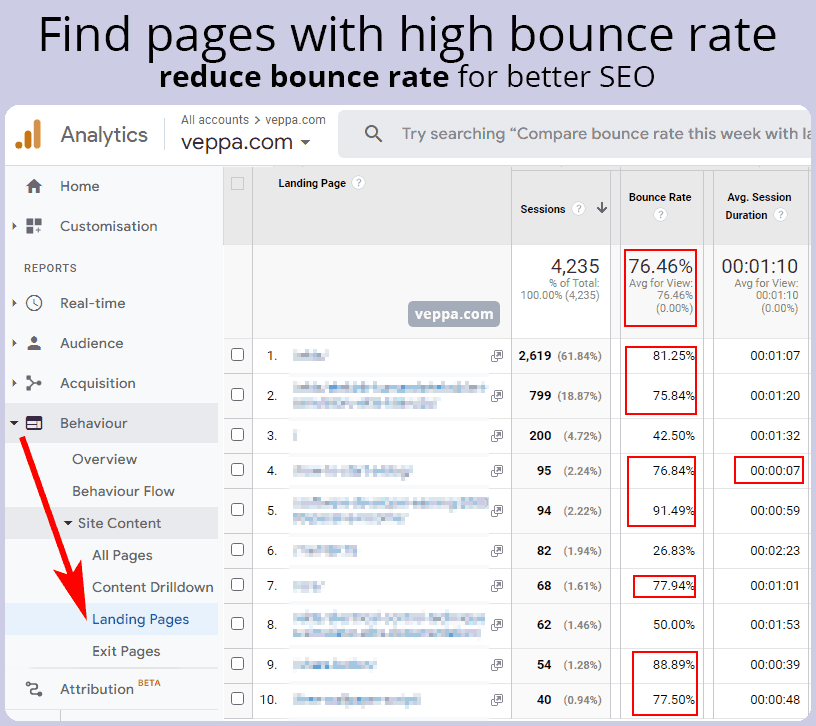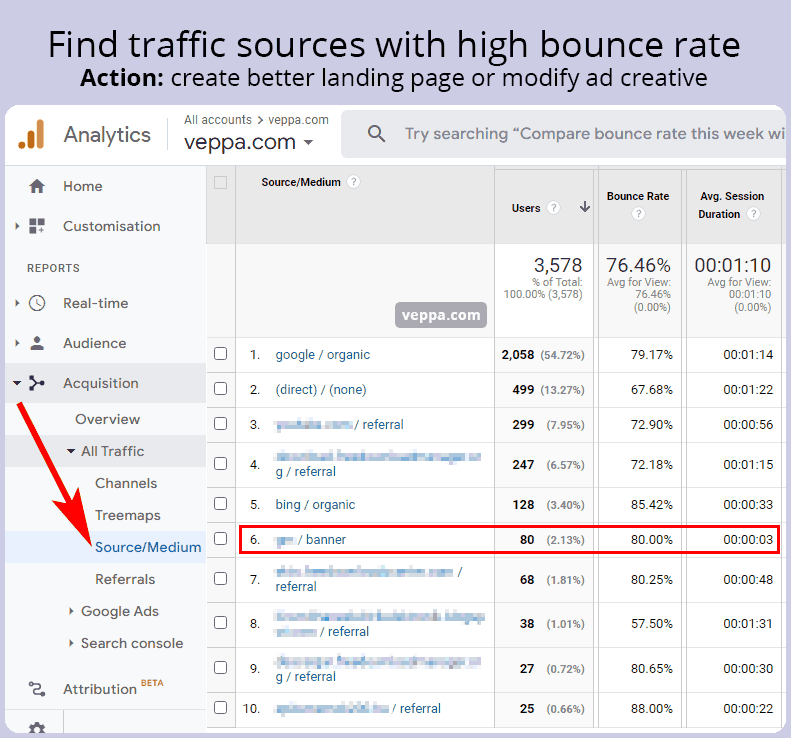Pages on your website should meet user expectations. When it is not matching user expectations you will get a high bounce rate that can damage your overall SEO. Follow tactics on this article to reduce bounce rate.
There are many ways to get traffic to your website. None of them are easy. Once you get a visitor to your website you need to make sure that they find what they are looking for. Otherwise there is no point of getting traffic that is not interested in your offering. When users leave your page not satisfied they will bounce back. Which is also known as bounce rate.
There may be many reasons for the high bounce rate. Our goal as a website owner is to find the reason for the high bounce rate and fix it.
In this article you will learn how to decrease the bounce rate of your website.

Table of Contents
How to reduce website bounce rate?
1. Make content easy to read
We all like content which is easy to scan for finding interesting areas or related parts and read without getting bored. Content presented in different formats make it easy to read and understand. Well formatted text will also save time for the reader.
Everything matters when creating well formatted content. Fonts family, font size, space between lines, sentence length, media files, bullet points, sub headings, jump links etc.
Here are main areas to pay attention when formatting easy to read content:
- Use small sentences and paragraphs.
- Break text with subheadings.
- Use images and video to better explain the topic.
- Use different formatting inside content like bullet list, quote, table.
- Remove or delay distractions like popups and ads.
Making your content easy to read will increase conversion and reduce bounce rate.
2. Have a great call to action on every page
Every page on your website should have a purpose. We want users to read content and take action. Action can be different for each page on your website.
For example, a content page can have a call to action to read related articles, subscribe to a newsletter, download content, visit affiliate links, purchase products etc. When a user takes action it will reduce your bounce rate. This means your content serves its purpose and increases conversion by moving visitors to the next sage through your funnel.
Simplest way of call to action is linking to related articles within your content. This also helps to boost your internal linking SEO and shape your site structure. Internal linking can also be applied as an additional call to action along with the main main one.
3. Use mobile friendly website
Mobile visitor count already surpassed desktop visitors. Responsive design is the way to make your website look good on mobile devices and provide the best user experience. If your website is not mobile friendly then it is time to update the design of your website with responsive themes.
WordPress has lots of mobile friendly responsive themes. Choose SEO optimized responsive themes with flexible features matching your criteria. Pay attention to having a mobile menu and search button built into the theme.
Check this guide for testing if your website is mobile friendly. Find suggested themes and plugins to make your WordPress website mobile friendly.
4. Make your website fast
Make sure that your pages load within 2 seconds. Slow load time will make users leave and look for faster loading websites. This is especially true on mobile devices.
There are 3 areas to make sure that your website loads fast on any device.
- Make sure that your website assets are small. Reduce file size of images, JavaScript, CSS, custom fonts.
- Make sure that your server responds fast. Web servers take time to generate dynamic web pages. This is usually an HTML page generated by WordPress or similar CMS software. Make sure you have a fast web server, minimum number of plugins and use some sort of content caching.
- Check JavaScript execution time to make sure that it is not slowing down on page user interaction. Remove any unnecessary animations, social share counters, pop ups, restyling pages with JavaScript.
Make your WordPress website fast with our detailed tutorial.
5. Write good meta description
Meta description is the way to attract visitors from search engines. Write a description for every post on your blog. Do not leave a meta description on autopilot. Provide a description using your primary target keyword and explain the content of your page. Show what visitors can expect from your web page. You will have a smaller bounce rate when visitors find what they were looking for.
On WordPress meta description for posts, pages and categories can be added using SEO plugins like RankMath.
6. Tailor separate landing page to each customer group
Same product can be presented from multiple perspectives for targeting users with different needs. Use it to target the right visitors to your website through different landing pages. Each landing page should focus on a topic expected from a particular target group.
Tailoring a separate landing page for each visitor group you can increase entry points to your website. Each page will have information closely related to the visitor group and you will reduce bounce rate for your website pages.
7. Make external link to open in new tab
Bounce rate increases when visitors leave your website with a single page view. To reduce bounce rate you can open all external links on your website to open in a new window (browser tab). Because visitors follow your article and click on links within it to apply your solution or view your references to learn more. After opening another web resource they still need to come to your article for completing it. Opening external links in a new window will make it easy to return to your page and complete the article. After completing your article they will probably continue with your call to action.
Any further interaction on your website like navigating to the next page or event like download, form submission, search, calling phone number etc. will reduce your bounce rate.
What is the bounce rate?
Bounce rate is the percentage of visitors that came to your web page and leaves without viewing any other page or doing any interaction. It is the percentage of single page visits. Having a high bounce rate means your website is not meeting user expectations.
Learn more about bounce rate from google analytics support article.
How is bounce rate calculated?
Formula for calculating bounce rate percentage is to multiply the number of sessions with a single page view with 100 and divide by the number of all sessions for a given period.
You can view the bounce rate in your google analytics report. There you can also find pages with high bounce rate and view traffic sources with high bounce rate.

How to find pages with a high bounce rate?
To reduce overall bounce rate for the website it is important to find popular pages with bounce rate higher than site average. If we fix those pages and reduce the bounce rate of them we will reduce the overall bounce rate for the whole website.

We will use Google analytics to find popular pages with a high bounce rate. In Analytics navigate to “Behaviour” → “Site content” → “Landing pages”. There you will see top pages where visitors land on your website. These pages are important because when users bounce they will check the page they landed on and leave your website without viewing any other page. So it is very important to reduce bounce rate on those pages.
Check pages with bounce rate higher than site average. In our case (shown in screenshot) average bounce rate is 76%. Pages higher than this average should be fixed.
Along with bounce rate, pay attention to “Average session duration”. Site average is 1:10 (one minute 10 seconds) and there is one page with session duration 7 seconds and high bounce rate. This means that the landing page is not interesting for that audience. We should fix content on that page or target a different audience for that page.
When we see high average session duration and high bounce rate this means visitors satisfied with that page and left completing their goal. It may be information they found on that page, files they downloaded, gained some knowledge they were eager to learn etc.
How to find traffic sources with a high bounce rate?
Generally websites have many traffic sources. To optimize conversion potential of each traffic source we can check them for high bounce rate with low session duration.

To find traffic sources with high bounce rate in google analytics navigate to “Acquisition” → “All traffic” → “Source/Medium” page. In our screenshot you see that “one banner” has a high bounce rate of 80% and average session duration 3 seconds.
This particular banner is:
- Placed on online game website
- Has banner promoting “how to create a blog”
- Linked to tutorial about creating a blog using WordPress.
According to google analytics data about bounce rate we can see that traffic is not interested in that content.
How to fix this not engaging traffic problem?
- Create content that will interest users where that banner is placed. In our case we can create content that will interest people who like to place online games. It may be content about games or tutorials about creating a game website.
- Remove banner from game website and place banner about creating blog on niche website that has lots of visitors who want to learn to create a blog.
We should regularly monitor traffic for high bounce rate when we use paid promotions in order to optimize our expenses and increase conversion rate.
FAQ about bounce rate
Why is bounce rate important for SEO?
High bounce rate tells how bad your content is performing for real users. When users coming from search engines do not engage and leave your website with a single page this tells that your content is not optimized. Try to optimize content to improve engagement and get more traffic from search engines.
What’s a good website bounce rate?
Bounce rate is generally between 30-70%. Good bounce rate would be between 30-50%. Bounce rate can vary depending on industry and website type. Even when you have bounce rate higher than 70% and average session duration bigger than 1 minute then your website may be providing good value to site visitors.
Is a very low bounce rate good?
Very low bounce rate which is lower than 10% is generally not good. It may be indicating that you have a bounce rate tracking problem in your analytics. You should fix your tracking problem to track real bounce rate for a website. Correct bounce rate will help you to measure and optimize your content for better user engagement.
What is the difference between bounce rate and exit rate?
Exit rate is calculated per page and indicates where users complete their journey generally with some interactions. Bounce rate is a single page view with no interaction at all.
Conclusion
Bounce rate helps to detect poorly performing landing pages. By optimizing your content and website design you can reduce bounce rate. Learn from pages with low bounce rate and apply the same tactics to pages with higher bounce rate.
Average session duration metric should be used in conjunction with bounce rate to detect pages that do not match user expectation. Improve those pages by creating better targeted content or targeting the right audience.
Bounce rate is some sort of quality indicator for your pages. Use it wisely and find ways to convert those bouncing visitors to your customers.
Regularly review your content for a high bounce rate and apply tactics discussed in this article to reduce it. Optimizing your content for high engagement and low bounce rate will also serve better to visitors coming from search engines.
Learn more search engine optimization by reading my detailed beginner friendly WordPress SEO guide.